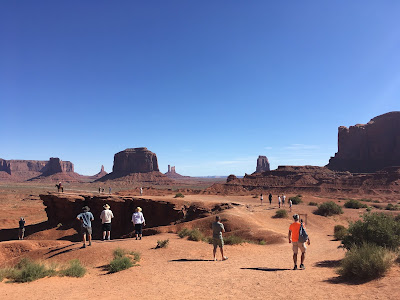Santa Fe is blessed with a number of fabulous museums showing a wide range of art. Somewhat belatedly, I have just visited the
Museum of International Folk Art for the first time in any depth, and I was blown away. The core of the museum's holdings is a collection of over 100,000 objects (not a typo) collected by Alexander Girard and donated to the museum. Ten thousand (yes, 10,000) of these objects are on permanent display in one giant room, the overwhelming and wonderful "Multiple Visions: A Common Bond" permanent exhibit. Girard was an avid collector of folk art objects from 100 countries and six continents, and these objects are carefully arranged in dioramas and wall displays. You could wander for a week in there discovering delightful things. When I spotted a wall of needlework samplers I told my companions that was where they could find me at the end of the day.
 |
| This sampler of elaborate darning stitches reminded me that today's "#visiblemending" is not so new after all! |
But that's not what I'm writing about today. This is just an extended introduction to the figure of Alexander Girard, a noted mid-20th-century designer of textiles, furniture and interiors. Mid-century modern design has been enjoying a revival for some time now, and it is pure pleasure to see lots of objects from that time in the exhibit
"Alexander Girard: A Designer's Universe." Perhaps the bright clear colors, clean design and upbeat mood of midcentury design appeals to us today for the same reason it did in the post-WWII, Cold War era.
 |
Some of Girard's textiles on display. The flat display case contains working designs for the fabrics as well as some of the inspirational textiles he collected on his travels.
|
What really made the exhibit fun for me was the peek into Girard's design process. The Vitra Design Museum in Germany organized the exhibit, and they included sketches, collages, and maquettes of many of Girard's projects in addition to the final products. Girard was not only a voracious collector of folk art, he was a prolific producer of ideas and designs. It was fun to see how he used watercolor sketches, collages, and miniature pasted-up textiles to develop designs just as we do today.
 |
| Girard's sketches for blanket designs. |
 |
| Maquettes for various interior design projects. |
 |
| The two long striped maquettes were for a "fabric mural" for a bank. |
 |
| Detail, fabric mural maquette |
One of my favorite glimpses into Girard's creative process was this manifesto of sorts. How many of us write notes to ourselves about the design principles we want to follow?
I know it's hard to read the text in this photo, so I'll pull out some of my favorite quotes:
"Space is our greatest luxury. Bulk and weight kill space. Lightness and economy make space."
"God made nature--don't spoil it. Nature's inspiration is honesty. Beauty can be simple too."
Girard's faith in "the modern" may seem quaint now: "Modern has magic--of modern science, of new discoveries, of a new world, of a better way of life." But he was adamant that there is no point in slavishly following traditional decor and designs that have outlived their time: "You don't wear a hooped skirt--why sit in a Victorian chair?"
"Don't look for a 'style' in modern--look for a way of living honestly. "
"Colors are yours to use--not for fashion to dictate."
"Respect the past--they believed in themselves. In the greatest tradition--be yourself!"
Some advice never goes out of style.
Girard's gift for whimsy is apparent in his designs for wooden dolls. I've never been a big fan of dolls, but these are totally charming to me.
 |
| Girard's sketches for wooden dolls. I wonder if their names--Fraidy, Smarty, Gloomy, Prissy, Snotty, Goopy and Cozy--are a sly reference to Disney's seven dwarfs? |
This exhibit runs through October 27. I just may go back a third time.



















